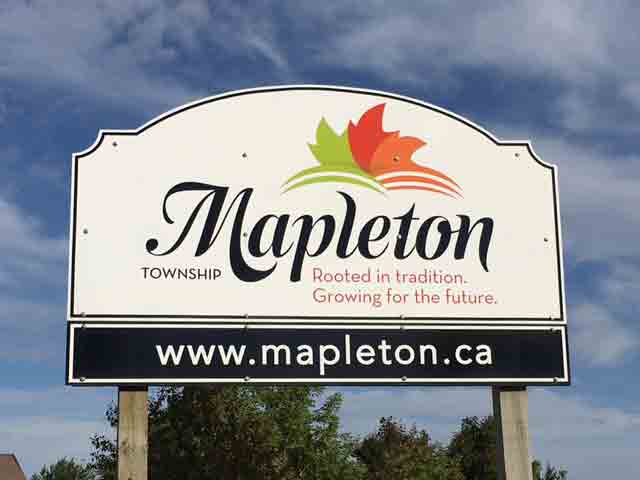DRAYTON – The latest version of Mapleton Township’s draft budget features a 2022 tax rate that is lower than earlier projected and a total tax burden that is actually lower than it was in 2020.
Finance director John Morrison told a handful of people who attended what was billed as a public budget workshop at the PMD arena on Nov. 18 the residential tax rate will rise by 1.64 per cent next year, rather than the 3.75% projected in a report to Mapleton council on Nov. 9.
The increase means residential taxpayers will pay a total of of $473 per $100,000 of assessment in 2022, an increase of $7.64 over the previous year.
The 2022 budget is the third in a three-year budget process the township implemented in 2020, Morrison explained.
Taxes dropped by just over $10 per $100,000 in assessment from 2020 to 2021, he noted, meaning even with this year’s increase, taxes for Mapleton homeowners are down by $2.69 (.56%) since 2020.
“Over the three years we actually have reduced the tax burden by $2.69,” said Morrison.
“But, you know, people being people, might not remember that they received a reduction of $10.33 the year before. But they did, so the year-over-year impact has been almost nil.”
The budget projects a 4.02% rise in the tax levy (the portion of the budget funded by taxation), an increase of $341,501 over the 2021 levy of $8,502,691.
Final data showing an increase in commercial assessment was the major factor in lowering the projected tax rate increase from the version of the budget presented to council on Nov. 9.
Overall, the township had weighted assessment growth of 2.34% in 2020, Morrison reported.
“That was a very healthy number that is mostly from commercial assessment, new commercial assessment, that came online. It’s not yet residential growth, but it is new commercial assessment that has helped moderate the rates downwards,” Morrison explained.
Other factors impacting the base operating budget for 2022 include:
- a 2.41% cost-of-living wage increase for township staff totalling $241,970 and associated benefits of .29% ($24,266);
- a 1.04% ($88,539) rise in insurance premiums; and
- addition of executive assistant and purchasing coordinator positions to township staff, adding $78,000 per position (.92%) to the budget.
Morrison said the new positions are needed to manage the data being used to improve the long-term budgeting process.
“We are asking for an executive assistant and purchasing coordinator, because we need to manage all this data. If we don’t manage it, we won’t be able to … provide the insight that’s necessary,” he explained.
Positively impacting the budget are savings of $6,486 (.08%) anticipated from removing planning services from the tax base by switching to a user-pay model and other operational savings totalling just under $126,000.
The latter savings resulted primarily from an increase in provincial contributions through the Ontario Municipal Partnership Fund and a reduction in expenditures for municipal drains, Morrison noted.
During a public question period a local ratepayer asked how the purchasing coordinator’s role would provide efficiencies.
Morrison explained that in 2020, the township introduced a new purchasing model.
“So for the first time the municipality is tracking its purchases, it’s issuing purchase orders and there’s a wealth of data that’s being gauged in that process,” he stated.
“So the purchasing coordinator would be really looking at the data and working with his or her counterparts throughout the county to try to find certain purchasing advantages.”
One Mapleton resident wondered why the township lowered tax rates earlier in the budget plan, only to raise them again in the third year.
“We took advantage of assessment growth in that year and we gave it back to the ratepayers in the middle of a pandemic,” Morrison explained.
“It was designed to help the taxpayers at a time of greater uncertainty. Now that everyone’s going back to work, we believe that we need to start gently increasing those tax rates again moving forward.”
Another resident wondered why only residents of Moorefield and Drayton, users of municipal water and wastewater, were being tapped to pay for the total cost of a new water tower and why Moorefield residents were being asked to pay at all for a tower that will be located in Drayton.
“Part of the principle that we’ve been installing is to create capacity and flexibility within the system,” said Morrison.
“And, and to try to keep a distinction between Moorefield and Drayton would be, in my opinion, a big mistake, because in the long run, you’re making it even more difficult to build in any kind of flexibility. Because the real intent here is to grow … to see more homes being built.”
Morrison noted a significant number of new homes are slated to be built in Drayton in the next couple of years and new ratepayers there will be helping to pay for at least $4 million worth of projects scheduled for the Moorefield system.
“So the combined Moorefield and Drayton residents will see that benefit as they grow,” he added.




